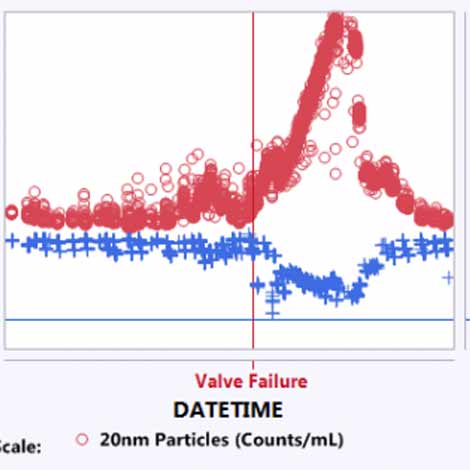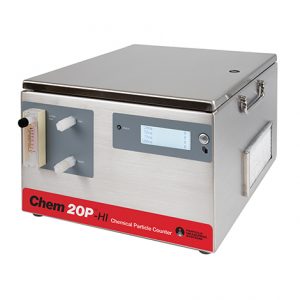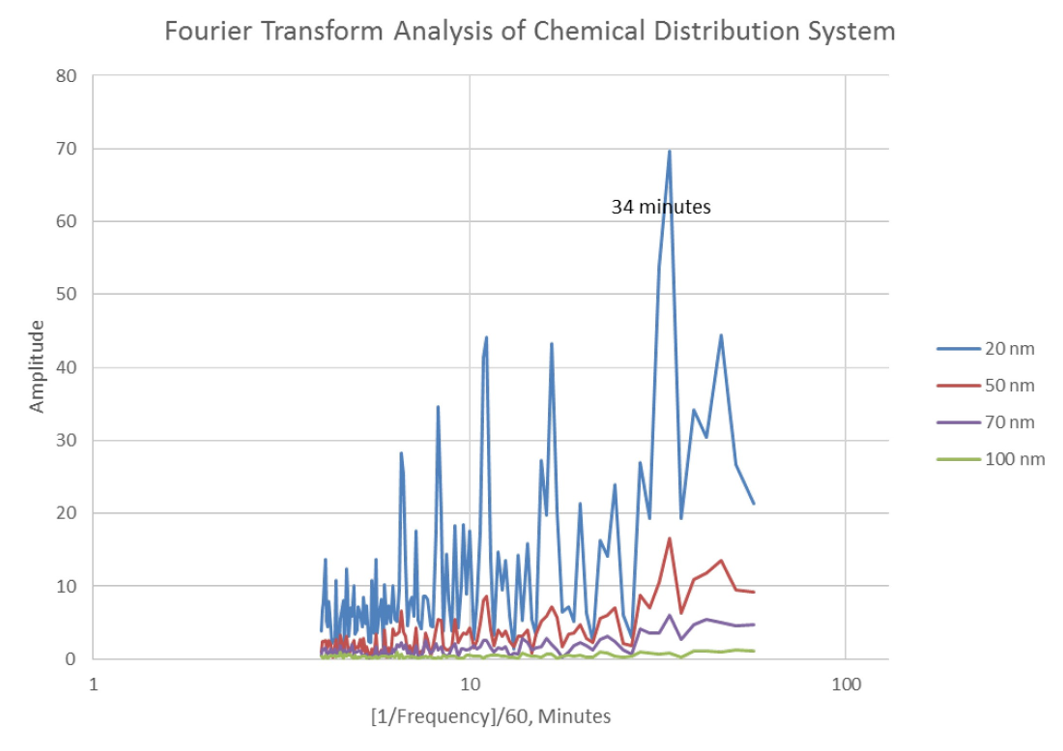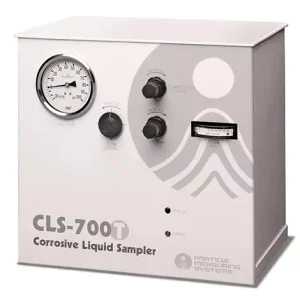
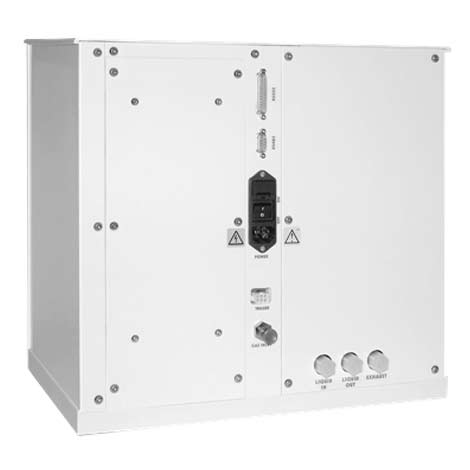
Accessories
Corrosive Liquid Sampler Installation Kit
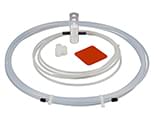
The CLS-700 T corrosive liquid particle sampler from Particle Measuring Systems (PMS) is a compression sampler combined with a LiQuilaz® particle counter for effective measurement of particles in fluids contained in unpressurized vessels. It is ideally suited for testing chemicals containing dissolved gas, where bubbles could be incorrectly detected as particles. The system eliminates bubbles by pressurizing the sample and keeping the bubbles suspended in solution.
Resources
Particle counting in process chemicals, especially effervescent and hot process chemicals used in the semiconductor industry, pose unique challenges when trying to measure particle concentration levels. Compression liquid samplers are widely used for both mobile batch sampling and continuous on-line sampling of these chemistries because of their ability to control bubble formation and minimize the effect they have on the resulting data. Samplers also offer tighter process control capabilities by monitoring in close proximity to the product, as in the case of a production wet-bench.

Liquid samplers must be optimized for the chemical of interest based on its viscosity, density, vapor pressure and effervescence. Physical parameters such as the location of the sampler from the chemical source, length and diameter of the sample tubing, and fluid elevation changes will affect the settings of the sampler, and therefore must be considered. It is not uncommon for a single sampler to be used with five to ten different chemistries having vastly different physical properties. This broad challenge requires the operator of the equipment understand that technique is a critical determinant in success or failure of the measurement. Experts from Particle Measuring Systems (PMS) discuss general guidelines based on field experience for configuring and optimizing the performance of a liquid compression sampler. A detailed discussion defining a proven sequence for optimizing a compression sampler is given, as well as suggested configurations for the most common process chemistries.
Solution: CLS 700T
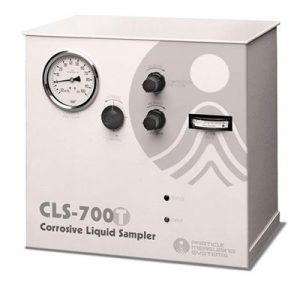 The CLS-700 T corrosive liquid particle sampler is a compression sampler combined with a LiQuilaz® particle counter for effective measurement of particles in fluids contained in unpressurized vessels. It is ideally suited for testing chemicals containing dissolved gas, where bubbles could be incorrectly detected as particles. The system eliminates bubbles by pressurizing the sample and keeping the bubbles suspended in solution. Learn more about this solution for particle counting in process chemicals.
The CLS-700 T corrosive liquid particle sampler is a compression sampler combined with a LiQuilaz® particle counter for effective measurement of particles in fluids contained in unpressurized vessels. It is ideally suited for testing chemicals containing dissolved gas, where bubbles could be incorrectly detected as particles. The system eliminates bubbles by pressurizing the sample and keeping the bubbles suspended in solution. Learn more about this solution for particle counting in process chemicals.
High-Purity Process Chemical Particle Contamination Control has become increasingly complex due to nanometer technology.
As semiconductor devices become increasingly complex, and the critical particle size for today’s leading-edge technology nodes decreases into the sub-10 nm size-range, the control and mitigation of potentially yield-impacting particle contamination at the smallest possible particle size becomes ever more crucial. Until recently, there has been a significant sensitivity gap between the critical particle size and the detection limit of traditional chemical particle counters. With industry-leading 20 nm sensitivity, the Chem 20™ chemical particle counter provides a comprehensive solution for the control and mitigation of particle contamination at 20 nm in ultra-pure chemical applications. The use-cases presented here show how the Chem 20 can be utilised throughout the microelectronics industry in a variety of applications at semiconductor manufacturers, chemical suppliers, and at tool and component suppliers.
The detection and elimination of yield-impacting particle contamination in high-purity process chemicals has been a continuous challenge in the semiconductor industry, and this challenge is becoming increasingly imperative as the critical particle size for modern technology nodes decreases to 10 nm and smaller. Traditional chemical particle counters, typically limited in sensitivity to particles around 30 to 40 nm in diameter or larger, no longer provide sufficient sensitivity for modern high-end process chemical applications. However, thanks to recent advances in laser optics and detector technology, the Chem 20 chemical particle counter provides particle sensitivity down to 20 nm in process chemicals, with 9 nm sensitivity in the case of metallic particles. This makes the Chem 20 the world’s most sensitive in-line chemical optical particle counter, providing real-time, actionable 20 nm particle data suitable for a wide range of high-purity process chemical applications throughout the microelectronics industry.
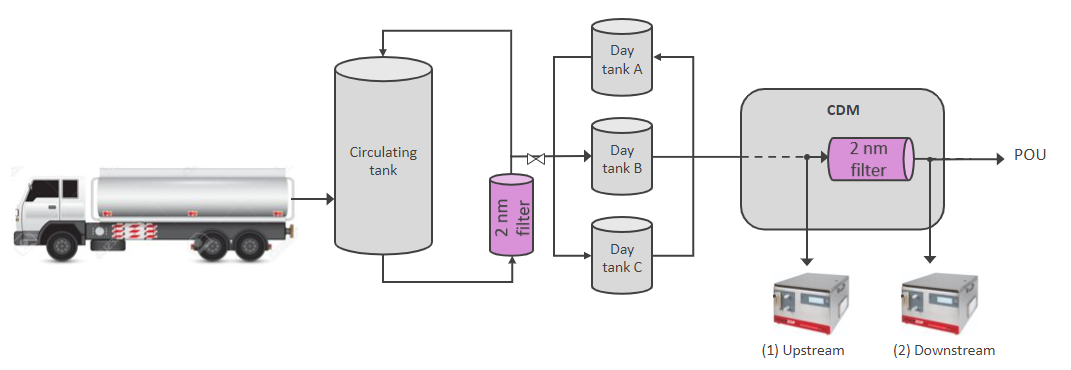
Since the performance of chemical particle counters is influenced by the refractive index of the chemical being measured, the Chem 20 is available in two configurations to ensure that optimal particle sensitivity is achieved in every application. The standard Chem 20 is optimised for low refractive index fluids including water, hydrofluoric acid, hydrogen peroxide, and ammonium hydroxide, while the Chem 20-HI is optimized for higher refractive index fluids including hydrochloric acid and sulphuric acid.
For high-sensitivity optical particle counters such as the Chem 20, a chemical media’s background light scattering, often referred to as molecular scattering, can become a significant problem. For some chemicals it can overwhelm the optical detector and prevent the detection of light scattered from particles. The Chem 20’s High-Scatter mode detects particles in many high-scattering chemicals that would otherwise be impossible, providing industry-leading particle sensitivity in the widest range of different process chemicals.
This application note presents a selection of applications that demonstrate how the Chem 20 particle counter can be a valuable tool for the control and mitigation of High-Purity Process Chemical Particle Contamination down to 20 nm.
Monitoring particles in process chemicals helps to improve yield. High particle levels in process chemicals have been shown to directly affect product quality. The need for continued reductions in particle size and quantity in cleanroom environments is well established. The International Technology Roadmap for Semiconductors (ITRS), sponsored by the United States Semiconductor Industry Association (SIA), defines the need for persistent decreases in particle levels in process gases, water, chemicals, and air in order to meet future generation technology nodes. The ability to accurately measure these contaminants is the first step in developing a comprehensive particle control plan.
While numerous techniques are available to monitor and characterize particulates, most require significant off-line analysis and interpretation. This usually reduces the number of measured samples resulting in fewer data points and time delayed results. Liquid Particle Counters (LPCs), based on light scattering, are widely used for continuous on-line particle monitoring of process chemicals. Proper selection and implementation of a liquid particle counter are important for ensuring data integrity.
Although the design, performance, and specifications of LPCs may differ, a few key principles remain the same. First, particle counters do not directly count particles. Particle counters based on light scattering are designed to measure the equivalent optical size of particles as referenced against a calibration standard. In most cases, that standard is a polystyrene latex sphere (PSL). These are readily available and National Institute of Standards and Technology (NIST) size traceable.

Laser light, with wavelengths usually between 600-800 nm, is used to illuminate the sample cell or capillary. As individual particles traverse the laser beam, light scattering occurs because of the index of refraction difference between the transport media and the particle. The amount of scatter depends on many factors but is largely dependent on the particle size, shape, and index of refraction.
Scattered light is then collected and focused onto a photodetector where the signal is converted into an electronic pulse.
The dashed lines represent the voltage values or channels defined for each particle size during calibration with PSLs.
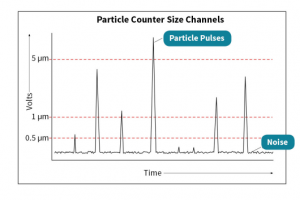
Each pulse represents an individual particle, while the magnitude of the pulse determines its size by comparing the PSL equivalent amount of scatter.
Particle contamination in chemical distribution systems can be difficult to find, but costly to yield when missed.
Advanced data analysis techniques can be implemented to quantitatively assess particle contamination data in state-of-the-art chemical distribution systems. Through examining the distribution of the rate of particle detection compared to Poisson’s distribution, it is possible to determine if particle variations are random or systematic and allow for the focus of improvement efforts to reduce particle levels with time. By analyzing the particle contamination data in the frequency domain via Fourier transform analyses, periodic cycles of contamination can be identified with the goal of associating contamination events with activities within the chemical delivery system.
Nanoparticle contamination is assessed based on the statistical distribution of the particle measurement rate. The statistical distribution of the rate of particle measurement will approach a Poisson distribution for fluids without systematic contamination sources. The deviation from Poisson statistics can be used as a figure of merit to quantify the stability of nanoparticle contamination in high purity chemical systems.
Fast Fourier Transform (FFT) algorithms can transform nanoparticle contamination data over time into its frequency components. This allows for the identification of cyclic, systematic contamination sources in the distribution system and is most usefully employed when the rate of particle detection deviates significantly from Poissonian statistics.
Chemical batch sampling helps detect particles within the distribution and use of chemicals for semiconductor manufacturing. Semiconductor chemical manufacturers face progressively tighter requirements for particle contamination limits. Proactive particle contamination control at 30 nm sensitivity is not enough for modern process technology operating far below this size. To meet this challenge, Particle Measuring Systems offers the Chem 20 chemical particle counter, streamlining online 20 nm particle specification control into current practices. As the first reliable 20 nm particle counter in the world, the physics behind moving the sensitivity below 30 nm required significant improvement of signal detection capabilities. Chem 20’s superior sensitivity is proven by its detection of events that went unnoticed by 30 nm and above particle counters, making great strides in quality improvements of liquid systems as a result.
Batch sampling of process chemicals
Particle size specification for process chemicals is a critical quality control for the semiconductor industry. Leading-edge microelectronics manufacturers require very clean process chemicals that are rigorously monitored for contamination and filtered to a particle size of 20 nm or below.
Particle Measuring Systems (PMS) offers the Chem 20™ as the world’s most sensitive particle sensor, propelling online particle specification down to 20 nm for the first time. The SLS-20 syringe sampler, combined with the Chem 20, provides the flexibility of offline batch sampling for a variety of applications, including process chemical research, production, distribution and packaging.
Read this paper to learn more about:
- World-leading 20 nm batch sampling of process chemicals
- How the system makes advances in waste reduction and safety
- Thorough investigations of common use cases performed in collaboration with PMS customers for a variety of chemicals
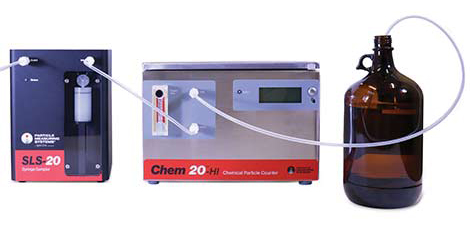
This paper, Written by Nora Colligan, Samsung Austin Semiconductor, focuses on a holistic approach to monitoring particles in ultra-pure chemicals from supplier all the way to the wafer surface. As critical dimensions shrink, this understanding will become very critical for cleaning equipment, processes, and the chemical delivery systems that supply them. Advancing technology in particle monitoring capabilities have made it possible to measure liquid particle counts of similar dimensions to wafer particle metrology, allowing the opportunity of a correlation of the two to be made. This paper presents examples of opportunities for particle improvement in all aspects of the supply chain, from supplier to point of use. Because of the complexity of these systems, there is further opportunity for particle monitoring to complete the correlation of liquid particle counts to wafer particle levels, and ultimately wafer yield.
